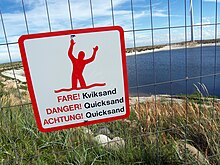Our website is made possible by displaying online advertisements to our visitors.
Please consider supporting us by disabling your ad blocker.
Quicksand


Quicksand is a mixture of water and sand or silt. It has the characteristic of thixotropy: it looks solid, but when pressure is applied it liquifies (acts like a liquid). If animals or people stand on it, they sink into it. However, a person does not drown in quicksand. A human or animal does not sink entirely into quicksand due to the higher density of the fluid.[1] It can be difficult to get out: that is the real problem. Quicksand may be escaped by slow movement of the legs in order to reduce viscosity of the fluid, and rotating the body so as to float on one's back (supine).[2]
Water circulation underground can focus in an area with just the right mixture of fine sands and other materials such as clay. The water moves up and then down slowly in a convection-like manner throughout a column of sand, and the sand remains a generally solid mass. This lubricates the sand particles and makes them unable to support any significant weight, since they move around with very little friction. They behave more like a liquid when exposed to stress. Since the water does not usually go all the way up through the sand, the sand above does not appear to move at all, and can support leaves and other small debris. This makes it difficult to distinguish quicksand from the surrounding environment.
- ↑ The science is: objects in liquefied sand sink to the level at which the weight of the object is equal to the weight of the displaced soil/water mix and the submerged object floats due to its buoyancy.
- ↑ Bakalarfor, Nicholas (2005). "Quicksand science: why it traps, how to escape". National Geographic News. Retrieved October 9, 2011.
Previous Page Next Page


